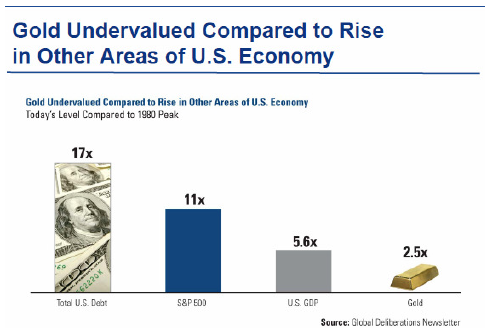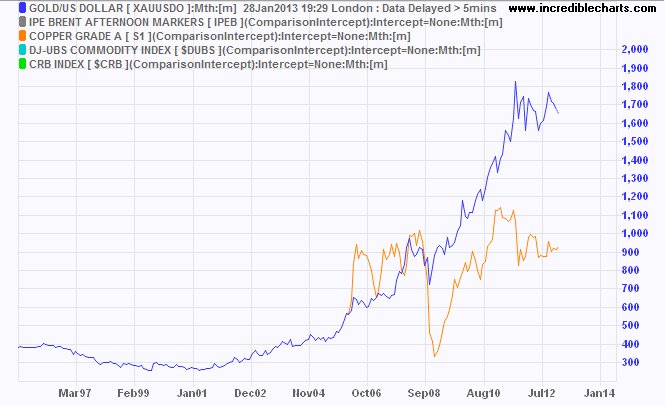Is Gold Undervalued
Post on: 12 Июнь, 2015 No Comment

The following is an excerpt from Richard Russell’s Dow Theory Letters
Guest post by Jon Strebler
The good news that trumps everything else is that I believe the BIG PICTURE is that the stock market, long term, is bullish, and that the stock market will be heading higher in the years ahead. Also, I expect some surprisingly bullish news to surface in the period ahead. – Richard Russell, June 6, 2013
Even though my good friend and mentor has distanced himself from this quote, I think he was onto something, and I’m going to keep referring back to it. Here is some of the “surprisingly bullish news ” that surfaced last week: U.S. Auto Sales Speed Up: Chrysler, Ford Race To Best June Since Crisis (Forbes, 7/2/2013); Home prices rise in May by most in 7 years (USA Today, July 2, 2013); U.S. Oil Prices Top $100 Mark …for the first time in more than a year. (Wall Street Journal, 7/3/2013); Report Shows Steady Jobs Growth (San Diego U-T, July 6, 2013).
These are not signs of an economy ready to collapse, nor one about to spiral into hyperinflation. Rather, they confirm what the PTI and Dow Theory have been telling us all along: It’s a bull market, and the US is doing a better job than most other countries in recovering from the Great Recession. It is self-evident that the strongest housing and auto markets in 6 years mean that a recession is not in the cards any time soon. Those are cyclical markets that remain strong or weak for years at a time; a reversal in the near future is therefore unlikely. And they are (still) the backbone of a strong economy.
Higher oil prices are another key indicator of a strong economy – and/or inflationary expectations. The latter doesn’t seem to be the case, as other inflationary indicators such as gold, silver, and commodity indexes are anything but strong. Below we can see the DJ –UBS Commodity index breaking below its 2012 lows; no sign of inflation there .
At the same time, concerns about the US dollar have all but evaporated. This chart compares it to the Australian dollar, a star when commodities were strong and the US currency’s future was questionable. Now we see that the ratio has cratered, confirming that the US’s adaptive, vibrant economy is a better bet than Australia’s commodities-based economy.
All of this helps explain why, with an overbought US stock market during the treacherous summer season, stocks haven’t dropped by even the 10% I had hoped for. Here we see that the S&P 500 (SPY ) only declined 8% from its highest levels, and is more than half way back up to those highs now.
None of this is good news for gold and the rest of the precious metals complex. Nobody really needs them when the economy is healthy, inflation is under control, and the currency is stable. That, I respectfully submit, is a more reasonable explanation of why gold is weak than some of the other stories you’ve been hearing.

Here’s the other thing that we (yes – this includes me) gold bugs need to acknowledge: In an important way, gold isn’t really a good investment. By definition, an investment creates wealth. Such as: Stocks are an investment, since (ideally) the underlying companies earn a profit yearly, which then – either via dividends, capital appreciation or both – creates wealth for shareholders. Similarly, bonds and real-estate are investments, as their interest payments and rental incomes steadily create wealth for their owners.
Evidence of this is found in the fact that $1 invested in large cap stocks back in 1925 is worth something like $3500 today (with dividends reinvested). Total return on real estate over that same time period has been similar. Gold, with $1 back then being worth only about $50 today, can’t compare in terms of creating wealth over the long-term. Since it and other pure asset plays don’t represent any form of economic activity, they don’t generate any income that one can count on to increase one’s wealth or – put another way – increase one’s purchasing power.
Instead, gold and similar assets are a way to preserve wealth, once it has been acquired. At least in the long run. Granted, if we buy gold when it is undervalued and starting to move up, then it can be a very profitable investment. But in the long-run, its price mostly just reflects the declining value of currency, a way to maintain our ability to purchase goods and services. Here is the classic example we’ve always used for this: An ounce of gold would buy a good quality men’s suit in 1900, and it will still buy a good quality men’s suit today – whatever year “today” represents. Of course, some years it would buy kind of a mediocre suit (e.g. 1999), while other years it might buy a couple of good suits (e.g. 2012). But overall, the relationship holds true.
So gold is a great way to retain one’s purchasing power in the long-run, but to reiterate: it is only a good investment when it is undervalued and about to move higher. This, of course, leads us to the big question: Is gold a good investment at this point? The answer is not clear, but is probably “no.” First of all, there are the fundamentals, laid out earlier in this commentary. The economy and dollar are sound, and inflation is not a concern in the foreseeable future. Second, gold is not really undervalued. It’s currently selling for 64 times its price of 100 years ago, while the CPI is only 24 times higher. This compares to ten years ago, when gold and the CPI were both up the same percentage from the year 1913; and 50 years ago, when gold was up only half as much as the CPI, with 1913 as a starting point. Thus, even after gold’s huge price drops this year, it is still above what could be considered its inflation-adjusted “fair value.”
To read the rest of Richard Russell’s Dow Theory Letters and receive daily updates, click here to subscribe.














